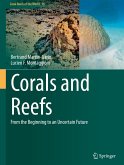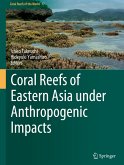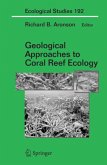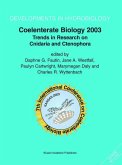Bertrand Martin-Garin, Lucien F. Montaggioni
Corals and Reefs
From the Beginning to an Uncertain Future
Bertrand Martin-Garin, Lucien F. Montaggioni
Corals and Reefs
From the Beginning to an Uncertain Future
- Broschiertes Buch
- Merkliste
- Auf die Merkliste
- Bewerten Bewerten
- Teilen
- Produkt teilen
- Produkterinnerung
- Produkterinnerung
The health status and future of tropical coral reefs, as tourist destinations, are regularly subjected to media coverage. Many documentaries recognize the natural beauty and biological richness of the Australian Great Barrier Reef and French Polynesian lagoons, but point to the equally significant risk that would result from current global warming and human-made hazards. The future of coral reefs is usually a matter of death foretold, real or purely imaginary. In this context, it has become necessary to differentiate between what is falling within reality of scientific facts or fantasy. To…mehr
Andere Kunden interessierten sich auch für
![Corals and Reefs Corals and Reefs]() Bertrand Martin-GarinCorals and Reefs108,99 €
Bertrand Martin-GarinCorals and Reefs108,99 €![Coral Reefs of Eastern Asia under Anthropogenic Impacts Coral Reefs of Eastern Asia under Anthropogenic Impacts]() Coral Reefs of Eastern Asia under Anthropogenic Impacts178,99 €
Coral Reefs of Eastern Asia under Anthropogenic Impacts178,99 €![Coral Reefs of Eastern Asia under Anthropogenic Impacts Coral Reefs of Eastern Asia under Anthropogenic Impacts]() Coral Reefs of Eastern Asia under Anthropogenic Impacts178,99 €
Coral Reefs of Eastern Asia under Anthropogenic Impacts178,99 €![Life on the Rocks Life on the Rocks]() Juli BerwaldLife on the Rocks20,99 €
Juli BerwaldLife on the Rocks20,99 €![Deep-water Coral Reefs Deep-water Coral Reefs]() Martin HovlandDeep-water Coral Reefs154,99 €
Martin HovlandDeep-water Coral Reefs154,99 €![Geological Approaches to Coral Reef Ecology Geological Approaches to Coral Reef Ecology]() Geological Approaches to Coral Reef Ecology154,99 €
Geological Approaches to Coral Reef Ecology154,99 €![Coelenterate Biology 2003 Coelenterate Biology 2003]() Daphne G. Fautin / Jane A. Westfall / Paulyn Cartwright / Marymegan Daly / Charles R. Wyttenbach (eds.)Coelenterate Biology 2003243,99 €
Daphne G. Fautin / Jane A. Westfall / Paulyn Cartwright / Marymegan Daly / Charles R. Wyttenbach (eds.)Coelenterate Biology 2003243,99 €-
-
-
The health status and future of tropical coral reefs, as tourist destinations, are regularly subjected to media coverage. Many documentaries recognize the natural beauty and biological richness of the Australian Great Barrier Reef and French Polynesian lagoons, but point to the equally significant risk that would result from current global warming and human-made hazards. The future of coral reefs is usually a matter of death foretold, real or purely imaginary. In this context, it has become necessary to differentiate between what is falling within reality of scientific facts or fantasy. To this end, the present general review, in the expert translation of Charlotte Fontan aims at: (1) defining the conditions and life requirements of reefbuilding corals; (2) the history of corals along with that of a number of associated, skeletal organisms involved in reef building since the very beginning, i.e. the last 540 million years, including the ups and downs they have experienced; (3) giving special reference to the development patterns of recent and modern reefs; (4) projecting corals and reefs into a still unknown future. Understanding how corals and reefs have originated, how they have been able to face the major biological crises which have punctuated the Earth's history, how they have survived is a prerequisite to better gain a significant picture of their future.
Produktdetails
- Produktdetails
- Coral Reefs of the World 16
- Verlag: Presses Universitaires de Provence / Springer / Springer International Publishing / Springer, Berlin
- Artikelnr. des Verlages: 978-3-031-16889-5
- 2023
- Seitenzahl: 176
- Erscheinungstermin: 26. Februar 2024
- Englisch
- Abmessung: 279mm x 210mm x 10mm
- Gewicht: 446g
- ISBN-13: 9783031168895
- ISBN-10: 3031168895
- Artikelnr.: 69867748
- Herstellerkennzeichnung Die Herstellerinformationen sind derzeit nicht verfügbar.
- Coral Reefs of the World 16
- Verlag: Presses Universitaires de Provence / Springer / Springer International Publishing / Springer, Berlin
- Artikelnr. des Verlages: 978-3-031-16889-5
- 2023
- Seitenzahl: 176
- Erscheinungstermin: 26. Februar 2024
- Englisch
- Abmessung: 279mm x 210mm x 10mm
- Gewicht: 446g
- ISBN-13: 9783031168895
- ISBN-10: 3031168895
- Artikelnr.: 69867748
- Herstellerkennzeichnung Die Herstellerinformationen sind derzeit nicht verfügbar.
¿Bertrand Martin-Garin is an associate professor at Aix-Marseille université. His skills are mainly guided by cnidarians - corals and jellyfish; coral reefs - in all their states! Paleontologist and marine biologist, the study of its organisms takes him on a spatio-temporal journey through the oceans and the seas of the Jurassic, the Miocene and the recent with themes related to climate and biodiversity, ecotoxicology, or mathematical concepts. Lucien F. Montaggioni is a professor emeritus at Aix-Marseille université. His skills refer to sedimentology and palaeoecology of coral reefs and shallow-water carbonate platforms, from the Oligo-Miocene to Recent, in relation to palaeoclimate and palaeoenvironmental reconstructions. His research has focused on systems from islands in the Western Indian Ocean, Red Sea, Australia, Myanmar, New Caledonia and French Polynesia.
INTRODUCTION: THE REEF PHENOMENON.- INTO THE INTIMACY OF CORALS, BUILDERS OF THE SEA.- 1 TAXONOMIC AFFILIATION.- 1.1 Systematic classification of cnidarians.- 1.2 Scleractinians.- 2 MORPHOLOGY AND ANATOMY.- 2.1 Polyp anatomy.- 2.2 Reproduction.- 2.2.1 Sexual reproduction.- 2.2.2 Asexual reproduction.- 2.3 Anatomy of calcareous skeletons.- 2.4 Coral colonies.- 2.4.1 Corallite arrangement.- 2.4.2 Colony morphology.- 3 SYMBIOSIS.- 4 BIOMINERALIZATION.- 4.1 Calicoderm and biomineralization.- 4.2 Skeletons and biomineralization.- 4.3 Interface between calicoderm and skeleton.- 4.4 Principles of calcification.- 5 NUTRITION.- 5.1 Prey capture.- 5.2 Food.- 5.3 Autotrophy.- THE MODERN TIMES.- 1 BIOZONATION.- 2 REEF MORPHOTYPES.- 2.1 Fringing reefs.- 2.2 Barrier reefs.- 2.3 Atolls.- 2.4 Bank reefs.- 2.5 High carbonate islands.- 3 GEOGRAPHICAL DISTRIBUTION.- 3.1 Ecological control.- 3.2 Tectonic control.- 3.3 Eustatic control.- 3.4 Topographic control.- 4 REEF GROWTH.- 4.1 Vertical growth strategies.- 4.1.1 Controlling factors.- 4.1.2 Give-up growth.- 4.1.3 Keep-up growth.- 4.1.4 Catch-up mode.- 4.2 Lateral growth.- 5 MORPHO-SEDIMENTARY PROCESSES.- 5.1 Bioconstruction.- 5.2 Erosion.- 5.3 Bioaccumulation.- 5.4 Cementation.- 6 INTERNAL STRUCTURE.- 6.1 Nature and distribution of facies.- 6.1.1 Framework facies.- 6.1.2 Detrital facies.- 6.1.3 Facies distribution and hydrodynamics.- 6.2 The different structural models.- 7 A BRIEF HISTORY OF REEF DEVELOPMENT.- 7.1 The climatic context.- 7.2 History of reef development since the last deglaciation.- 7.3 Reef history throughout the Pleistocene.-8 RECORD OF ENVIRONMENTAL CHANGES.- 8.1 Record at the coral colony scale.- 8.1.1 Temperature.- 8.1.2 Salinometry.- 8.1.3 Rainfall.- 8.1.4 pH measurement.- 8.1.5 Photometry.- 8.1.6 Current measurement.- 8.2 Record at the scale of a reef edifice.- 8.2.1 Reef flats and micro-atolls.- 8.2.2 Arrangement of coral communities.- 8.2.3 Arrangement of reef edifices.- THE LONG MARCH OF CORALS.- 1 THE TIME OF THE ORIGINS.- 1.1 Early Earth and the first traces of life.- 1.2 Evolution of the atmosphere.- 1.3 Geochemical model of the early ocean.- 1.4 Emergence of biomineralization.- 1.5 The early calcifying organisms and cnidarians.- 1.6 The earliest corals.- 1.7 The appearance of scleractinian corals.- 2 THE TIME OF DIVERSIFICATION.- 2.1 Coral-algae symbiosis.- 2.1.1 Acquiring photosymbiosis.- 2.1.2 Evidence of photosymbiosis.- 2.1.3 Symbiosis and coloniality.- 2.2 A brief history of coral and reef building.- 2.2.1 Paleozoic times.- 2.2.2 Mesozoic times.- 2.2.3 Cenozoic times.- THE HIGHS AND LOWS OF THE REEF PHENOMENON.- 1 CAUSES.- 1.1 Causal relationships.- 1.2 Gas emissions and volcanic products.- 1.3 Methane emissions.- 1.4 Thermogenic gases.- 1.5 The fall of celestial bodies.- 1.6 Behaviour of organisms facing environmental disturbances.- 1.7 Disturbances induced by CO2 and ocean acidification.- 1.8 Thermal shocks.- 1.9 Disturbances induced by ocean deoxygenation.- 2 THE MAIN BIOLOGICAL CRISES.- 2.1 The Cambrian crises.- 2.2 The major crisis of the Ordovician end.- 2.3 The minor crises of the Silurian.- 2.4 The successive crises of the Devonian.- 2.5 The Permian crises.- 2.6 The Triassic crises.- 2.7 The lower Jurassic crisis.- 2.8 The Jurassic-Cretaceous transition (J-K).- 2.9 The Cretaceous-Paleogene crisis.- 2.10 The Paleocene-Eocene crisis.- 2.11 The Eocene-Oligocene transition.- 2.12 The Oligocene end to the Plio-Quaternary.- 3 THE RESPONSE OF CORALS AND REEFS TO CRISES: FROM EXTINCTION TO RECOVERY.- 3.1 At the Ordovician end.- 3.2 During the Silurian.- 3.3 During the Devonian.- 3.4 At the Permian.- 3.5 At the Permian-Triassic boundary.- 3.6 From the middle to the end of the Triassic.- 3.7 During the Jurassic.- 3.8 From the upper Jurassic to the lower Cretaceous.- 3.9 At the Cretaceous-Paleogene (K-Pg) transition.- 3.10 From the Paleocene to the Eocene.- 3.11 From the Oligocene to the Miocene.- 3.12 During the Plio-Quaternary.- 4 CONCLUSIONS.- CORAL REEFS IN THE FACE OF THEIR FATE.- 1 DISRUPTIVE AGENTS IN ACTION.- 1.1 Carbon dioxide and rising surface water temperatures.- 1.2 Carbon dioxide and its effects on the carbonate cycle.- 1.3 Carbon dioxide and ocean acidification.- 1.4 The other disruptive agents.- 2 THE RESPONSE OF CORALS AND CORAL REEFS.- 2.1 Temperature rise of surface waters.- 2.2 To acidification.- 2.3 To other disruptive agents.- 3 THE EVOLUTION OF CORAL ISLETS.- 3.1 The modes of low-lying island formation.- 3.2 Future evolution of low-lying islands: maintenance, reduction, or destruction?.- CONCLUSIONS.- BIBLIOGRAPHY.- INDICE.
INTRODUCTION: THE REEF PHENOMENON.- INTO THE INTIMACY OF CORALS, BUILDERS OF THE SEA.- 1 TAXONOMIC AFFILIATION.- 1.1 Systematic classification of cnidarians.- 1.2 Scleractinians.- 2 MORPHOLOGY AND ANATOMY.- 2.1 Polyp anatomy.- 2.2 Reproduction.- 2.2.1 Sexual reproduction.- 2.2.2 Asexual reproduction.- 2.3 Anatomy of calcareous skeletons.- 2.4 Coral colonies.- 2.4.1 Corallite arrangement.- 2.4.2 Colony morphology.- 3 SYMBIOSIS.- 4 BIOMINERALIZATION.- 4.1 Calicoderm and biomineralization.- 4.2 Skeletons and biomineralization.- 4.3 Interface between calicoderm and skeleton.- 4.4 Principles of calcification.- 5 NUTRITION.- 5.1 Prey capture.- 5.2 Food.- 5.3 Autotrophy.- THE MODERN TIMES.- 1 BIOZONATION.- 2 REEF MORPHOTYPES.- 2.1 Fringing reefs.- 2.2 Barrier reefs.- 2.3 Atolls.- 2.4 Bank reefs.- 2.5 High carbonate islands.- 3 GEOGRAPHICAL DISTRIBUTION.- 3.1 Ecological control.- 3.2 Tectonic control.- 3.3 Eustatic control.- 3.4 Topographic control.- 4 REEF GROWTH.- 4.1 Vertical growth strategies.- 4.1.1 Controlling factors.- 4.1.2 Give-up growth.- 4.1.3 Keep-up growth.- 4.1.4 Catch-up mode.- 4.2 Lateral growth.- 5 MORPHO-SEDIMENTARY PROCESSES.- 5.1 Bioconstruction.- 5.2 Erosion.- 5.3 Bioaccumulation.- 5.4 Cementation.- 6 INTERNAL STRUCTURE.- 6.1 Nature and distribution of facies.- 6.1.1 Framework facies.- 6.1.2 Detrital facies.- 6.1.3 Facies distribution and hydrodynamics.- 6.2 The different structural models.- 7 A BRIEF HISTORY OF REEF DEVELOPMENT.- 7.1 The climatic context.- 7.2 History of reef development since the last deglaciation.- 7.3 Reef history throughout the Pleistocene.-8 RECORD OF ENVIRONMENTAL CHANGES.- 8.1 Record at the coral colony scale.- 8.1.1 Temperature.- 8.1.2 Salinometry.- 8.1.3 Rainfall.- 8.1.4 pH measurement.- 8.1.5 Photometry.- 8.1.6 Current measurement.- 8.2 Record at the scale of a reef edifice.- 8.2.1 Reef flats and micro-atolls.- 8.2.2 Arrangement of coral communities.- 8.2.3 Arrangement of reef edifices.- THE LONG MARCH OF CORALS.- 1 THE TIME OF THE ORIGINS.- 1.1 Early Earth and the first traces of life.- 1.2 Evolution of the atmosphere.- 1.3 Geochemical model of the early ocean.- 1.4 Emergence of biomineralization.- 1.5 The early calcifying organisms and cnidarians.- 1.6 The earliest corals.- 1.7 The appearance of scleractinian corals.- 2 THE TIME OF DIVERSIFICATION.- 2.1 Coral-algae symbiosis.- 2.1.1 Acquiring photosymbiosis.- 2.1.2 Evidence of photosymbiosis.- 2.1.3 Symbiosis and coloniality.- 2.2 A brief history of coral and reef building.- 2.2.1 Paleozoic times.- 2.2.2 Mesozoic times.- 2.2.3 Cenozoic times.- THE HIGHS AND LOWS OF THE REEF PHENOMENON.- 1 CAUSES.- 1.1 Causal relationships.- 1.2 Gas emissions and volcanic products.- 1.3 Methane emissions.- 1.4 Thermogenic gases.- 1.5 The fall of celestial bodies.- 1.6 Behaviour of organisms facing environmental disturbances.- 1.7 Disturbances induced by CO2 and ocean acidification.- 1.8 Thermal shocks.- 1.9 Disturbances induced by ocean deoxygenation.- 2 THE MAIN BIOLOGICAL CRISES.- 2.1 The Cambrian crises.- 2.2 The major crisis of the Ordovician end.- 2.3 The minor crises of the Silurian.- 2.4 The successive crises of the Devonian.- 2.5 The Permian crises.- 2.6 The Triassic crises.- 2.7 The lower Jurassic crisis.- 2.8 The Jurassic-Cretaceous transition (J-K).- 2.9 The Cretaceous-Paleogene crisis.- 2.10 The Paleocene-Eocene crisis.- 2.11 The Eocene-Oligocene transition.- 2.12 The Oligocene end to the Plio-Quaternary.- 3 THE RESPONSE OF CORALS AND REEFS TO CRISES: FROM EXTINCTION TO RECOVERY.- 3.1 At the Ordovician end.- 3.2 During the Silurian.- 3.3 During the Devonian.- 3.4 At the Permian.- 3.5 At the Permian-Triassic boundary.- 3.6 From the middle to the end of the Triassic.- 3.7 During the Jurassic.- 3.8 From the upper Jurassic to the lower Cretaceous.- 3.9 At the Cretaceous-Paleogene (K-Pg) transition.- 3.10 From the Paleocene to the Eocene.- 3.11 From the Oligocene to the Miocene.- 3.12 During the Plio-Quaternary.- 4 CONCLUSIONS.- CORAL REEFS IN THE FACE OF THEIR FATE.- 1 DISRUPTIVE AGENTS IN ACTION.- 1.1 Carbon dioxide and rising surface water temperatures.- 1.2 Carbon dioxide and its effects on the carbonate cycle.- 1.3 Carbon dioxide and ocean acidification.- 1.4 The other disruptive agents.- 2 THE RESPONSE OF CORALS AND CORAL REEFS.- 2.1 Temperature rise of surface waters.- 2.2 To acidification.- 2.3 To other disruptive agents.- 3 THE EVOLUTION OF CORAL ISLETS.- 3.1 The modes of low-lying island formation.- 3.2 Future evolution of low-lying islands: maintenance, reduction, or destruction?.- CONCLUSIONS.- BIBLIOGRAPHY.- INDICE.








